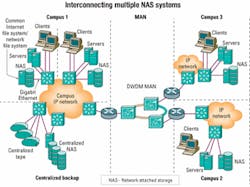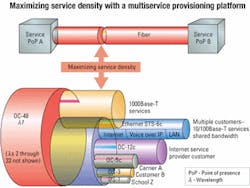The case for Ethernet over DWDM
Ethernet over DWDM is an efficient metro architecture for reliable high-bandwidth data delivery.
INDRAJIT ROY and TEJAS VASHI, Cisco Systems
E-business and streaming media applications are placing new demands on access, MANs, and WANs. To meet these challenges, enterprises and service providers are adopting a new network architecture that combines the high-speed, low-cost, plug-and-play capabilities of Ethernet in the data layer with the reach, scalability, reliability, and resiliency of optical networks in the transport layer-Ethernet over DWDM.
For enterprises, this option makes sense. Ethernet has enjoyed overwhelming popularity in enterprise networks and thus has the advantage of economies of scale; abundant Ethernet and IP technology development, a large installed base, traffic engineering, and staff resources already exist.
The attractiveness of DWDM for enterprises is also clear. First, DWDM offers protocol independence, so companies can transport virtually any traffic-existing data, storage, and TDM. Second, it is bandwidth- and cost-efficient, giving companies the ability to maximize their fiber investment and realize a huge cost savings. It was only a matter of time before enterprises sought to integrate Ethernet with DWDM to achieve the elimination of bandwidth bottlenecks between enterprise LANs and MAN backbones.
Recognizing the significance of the Ethernet groundswell, metro service providers are busy deploying the infrastructure necessary for offering high-performance data services. These services are targeted at customers desiring high-bandwidth Internet applications, intercampus networking through transparent LANs, and outsourcing applications such as data warehousing. Internet-based software and the distribution, or streaming, of video and music not only create demand for high bandwidth, but these applications also enable businesses to justify broadband networking costs. At the same time, businesses focused on group collaboration, e-learning, gaming, and broadband entertainment are increasing the demand for audio/video streaming, which requires a high-bandwidth and low-jitter network. Other key network requirements driving the demand for Ethernet over DWDM include:
- Flexible, high-speed network access that matches user bandwidth needs with carrier service rates, with scalable access bandwidth from megabits per second to gigabits per second.
- New revenue-generating services such as advanced IP services (voice over IP, videoconferencing, video on demand, Web hosting, content delivery), transparent LAN services, and virtual private networking to compensate for bandwidth commoditization.
- Network resiliency that provides extensive fail-over and network restoration capabilities.
- The ability for end users to connect to public services using the simple, inexpensive and ubiquitous Ethernet interface.
By its very nature, Ethernet over DWDM can support a myriad of applications in enterprise metro networks. However, two deployment scenarios in particular highlight the inherent value of this technology: consolidation of network attached storage (NAS) and 10-Gigabit Ethernet (10-GbE) connectivity.
Consolidation of network attached storage
Today, many enterprises are migrating from a costly, inefficient server attached storage model to the more scalable, manageable networked storage model. One reason for its popularity is that most NAS systems, or filers, run over Ethernet/IP networks. In fact, NAS has led the way for the mainstream deployment of IP-based storage consolidation and file sharing, making it the first true IP storage technology. NAS is popular in a large number of environments, including collaborative development, engineering, e-mail, Web, and general file serving.
In and of itself, NAS is a decentralized storage networking technique, with filers dispersed throughout the enterprise in a standard deployment. To maximize the utilization of the available storage and sharing of resources among different deployments within the enterprise, a networking technology is required as a consolidation point.As Figure 1 illustrates, DWDM is an ideal solution for interconnecting multiple NAS-enabled sites within the MAN. Delivering 32 wavelengths or more per fiber pair, DWDM can assign individual wavelengths for each high-bandwidth application. This capability allows bandwidth to be allocated and prioritized across wavelengths to ensure quality of service (QoS) for critical applications such as backup and recovery.
10-GbE connectivity
With more than 300 million switched Ethernet ports already installed worldwide, the wide adoption of 10-GbE is practically a foregone conclusion. Information technology managers deploying 10-GbE will have several key advantages from the start, including investment protection in the installed equipment, network management and analysis tools, and expertise or familiarity with the technology.
These benefits make 10-GbE a very cost-effective way to build 10-Gbit/sec links within the enterprise. The primary reason for this affordability is the design philosophy of the Ethernet industry, which assumes high-volume manufacturing and low-cost design. A design goal adopted by the IEEE task force is the development of 10-GbE interfaces that offer 10 times the performance at three to four times the cost of the previous generation of Ethernet.
Transporting Ethernet-based 10-Gbit/sec links using DWDM equipment will be a natural fit when 10-Gbit/sec per wavelength transport becomes the industry standard. Access to 10-GbE services over DWDM will enable high-end data-networking applications such as serverless buildings and storage applications such as remote backup and disaster recovery.
Indeed, the very low latency and high bandwidth offered by the combination of DWDM and 10-GbE satisfies the mission-critical business requirements of these applications. In short, the availability of ample bandwidth and the protocol independence of DWDM allow for GbE, 10-GbE, and other services to flow at full throughput.
Service-provider opportunity
While some large enterprise customers may attempt to lease fiber or gain rights of way and build their own metro Ethernet infrastructure, many others will rely on metro service providers for these services. As such, service providers are busy restructuring their networks to deliver flexible Ethernet services.
For these service providers, DWDM is an outstanding way to multiply network capacity and deliver high-bandwidth services to large customers. Nevertheless, metro service providers can face an expensive and daunting task when restructuring their networks.
While service providers have many options when designing their networks to deliver Ethernet services, the service portfolio, customer base, and existing infrastructure often lead to one of two likely scenarios. Service providers augmenting voice services with data or wavelength services generally employ Ethernet over SONET over DWDM as a way to efficiently aggregate multiple lower-speed connections. Carriers focusing on data services only, or those providers that need to transport multiple high-speed connections such as GbE or higher, are likely to focus on Ethernet over DWDM.
SONET is the established transport in virtually all MANs because it provides the redundancy and resiliency essential for voice traffic. In recent years, next-generation SONET has emerged, combining the benefits of traditional SONET with the scalability and flexibility required by evolving networks. Next-generation SONET combines multiple bit-rate support in one platform. This flexibility provides a migration path as customers demand more capacity and higher-bandwidth services. Next-generation platforms also allow service providers to use and build on their SONET expertise.Service providers augmenting their TDM-based infrastructures to deliver Ethernet services must maximize the revenue streams of current voice services, while adding data to their networks. These providers may also want to design architectures with the flexibility and scalability to support future diversification of their TDM, Ethernet, and wavelength services.
The increasing need for a variety of data, voice, and video services along with scalable next-generation SONET has given rise to a new generation of multiservice provisioning platforms (MSPPs) optimized for metro networks. MSPPs are designed to support a wide range of services from one platform with only simple card changes required for service upgrades. Thus, MSPPs enable service providers to incrementally augment their service offerings with data services, while at the same time maximizing the revenue streams of existing voice traffic. In addition, MSPPs can aggregate a full range of Ethernet services at standard rates from 10 Mbits/sec to 10 Gbits/ sec, with fractional-rate and oversubscription services also available. All of that combined enables service providers to maximize service density and profitability by efficiently packing wavelengths with services (see Figure 2).
MSPPs also provide a direct interface to metro DWDM solutions. By adding DWDM to the Ethernet-over-SONET equation using an MSPP solution, service providers can scale capacity easily and on an "as needed" basis. Service providers employing this architecture benefit from SONET protection schemes, multiservice capabilities, scalable capacity, and an incremental migration path to deliver Ethernet services.
Data services
Ethernet over DWDM is the other primary scenario that service providers use to deliver data services to their enterprise customers. The data local-exchange carrier (DLEC) is a type of competitive local-exchange carrier (CLEC) that specializes in data delivery. Incumbent local-exchange carriers and CLECs with their own fiber lease high-speed services to DLECs and other CLECs, which in turn lease more granular services to their customers. The logical organization of this type of network is often anything that makes business sense, from a few point-to-point connections to a complete overlay of the incumbent metro network.
For DLECs and Ethernet service providers, Ethernet directly over DWDM is the most cost-effective and efficient way to deliver data services to their enterprise customers. These service providers employ metro DWDM to scale networks to meet their customers' service requirements. With DWDM, DLECs and Ethernet service providers can maximize Ethernet services over a single fiber for greater profitability.
Additionally, an Ethernet-over-DWDM architecture enables data service providers to utilize optical protection to bring a new level of reliability to Ethernet customers. By combining Ethernet and DWDM, these service providers can implement and achieve carrier-class QoS and service-level agreements for their Ethernet services.
Radical economics
The unlimited capacity of metro DWDM, coupled with the rising demand for Ethernet, enables a faster return on investment for enterprises and service providers that use Ethernet-over-DWDM architectures. Payback scenarios that previously entailed up to two years or more are now possible in as little as a single quarter. This radical economic paradigm ushered in by a new generation of metro access and transport equipment benefits everyone. Service providers can tap new sources of revenue, while customers have new types of high-bandwidth services available for a lower cost per bit.
Increasing demand for high-speed data services and rapid fiber build-outs in the metro are leading enterprises and service providers to deploy Ethernet-over-DWDM network architectures. Since transparent LANs, data storage networks, and other new forms of wide-area enterprise networking are still in their infancy, DWDM and metro Ethernet services can only serve to stimulate further applications development. In future metro networks, high-bandwidth data delivery enabled by Ethernet over DWDM will play a major role for enterprises and service providers alike.
Indrajit Roy is manager of product management for the metropolitan services business unit and Tejas Vashi is manager of market development for the optical transport business unit at Cisco Systems (San Jose, CA).


